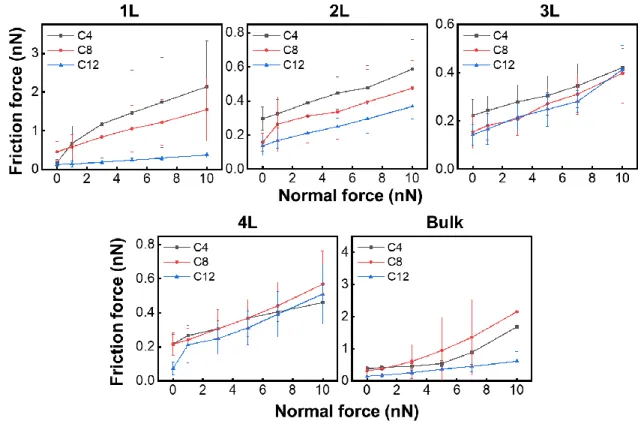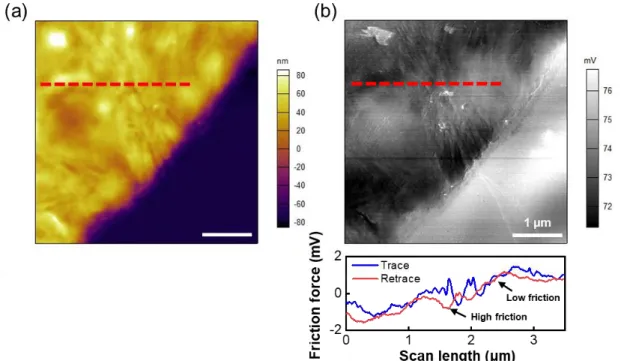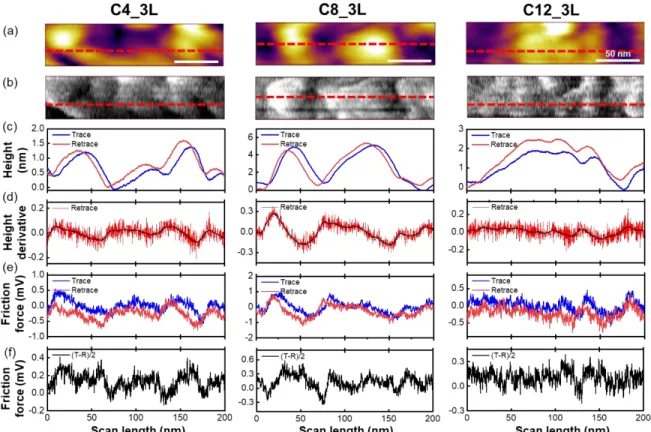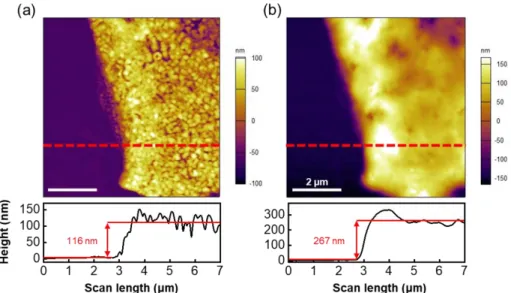In this work, the thickness-dependent frictional properties of 2D HOIPs were quantitatively investigated using atomic force microscopy (AFM) under various normal forces to determine the frictional behavior. Three types of 2D HOIPs with different organic chain length were used to investigate the effect of the organic chain length on friction properties, and also the effect of the number of layers was investigated. The results showed thickness-dependent behavior on the frictional properties at the nanoscale and the effect of chain length becoming less significant with increasing the number of layers.
These results can help to gain a fundamental understanding of the frictional characteristic of atomically thin 2D HOIPs, so that the results can contribute to the expansion of their applications. Colored octahedra represent [PbI6]4−. The black arrow indicates the increase in the distance of the inorganic layers with increasing length of the organic spacer, ranging from 7.4 to 17 Å [17]. The red dashed lines indicate the location where the cross-sectional elevation profiles were obtained.
Frictional force as a function of normal force of atomically thin 2D HOIPs for. investigation of the effect of organic chain length.. a) Effect of organic chain length on out-of-plane elastic modulus [17], (b). Average adhesion forces between the AFM tip and atomically thin 2D HOIPs determined before and after FFM measurements. a) Topography and (b) FFM images of bulk C8. Friction force as a function of a normal force of atomically thin 2D HOIPs for investigating the effect of the number of layers.. a) Topographic images obtained and (b) FFM of three-layer 2D HOIPs. simultaneously by AFM contact mode under normal force of 5 nN.
Red dashed lines indicate the locations where cross-sectional height profiles, height derivatives and friction loops were taken.
INTRODUCTION
Background and motivation
One effective way to improve environmental stability is to reduce the dimensionality of 3D HOIP crystals into multilayer two-dimensional (2D) HOIPs [13]. Due to the presence of soft organic layers, 2D HOIPs are among the most compliant materials compared to other 2D materials, and the mechanical properties of 2D HOIPs can be determined by the competition between rigid inorganic layers, soft organic layers, and weak layers. van der Waals interfaces [17]. Considering that 2D HOIPs are used as thin films, understanding the contact surface characteristics such as adhesion and friction is important.
Since the perovskite not only serves as a triboelectrification material but also a photon absorbing material in the TENG [19], the study of friction properties at the nanoscale is necessary for improved applicability of 2D HOIPs beyond solar cells. Since 2D HOIPs are a mixture of organic layers and inorganic layers, the organic chain length is one of the crucial factors that determine the performance of solar cells. 2D HOIPs with longer organic chain length have fewer surface defects and higher hydrophobicity, resulting in higher power conversion efficiency and long-term durability against moisture [20].
For this reason, it is expected that the length of the organic chain also affects the friction properties, so it is necessary to identify the effect of the length of the organic chain on the friction behaviors for a systematic understanding of the fundamental characteristics of friction. Furthermore, the frictional strength of atomically thin 2D materials was found to be strongly dependent on the number of layers [21–25], therefore investigating the effect of the number of layers is also important.
Objective
EXPERIMENTAL DETAILS
Sample preparation and characterization
The black arrow indicates the increase in the distance of the inorganic layers with increasing the length of the organic spacer, which varies from 7.4 to 17 Å [17]. Due to the presence of weak van der Waals interfaces between 2D HOIPs layers, atomically thin 2D HOIPs were deposited on silicon substrates with 285 nm thick thermally grown SiO2 by mechanical exfoliation [26, 27] from synthesized single crystal forms. Subsequently, atomically thin 2D HOIPs were detected by optical microscopy (VK-X200, Keyence) but their optical contrast on SiO2/Si substrate was relatively low.
Therefore, single-layer 2D HOIPs are randomly located near thicker ones, because the optical contrast of atomically thin 2D HOIPs increased as the number of layers increased. Furthermore, the number of layers was determined by AFM (Atomic Force Microscopy, MFP-3D, Asyl Research). To minimize the damage of both 2D HOIPs and AFM tips, topographic images were acquired under the intermittent contact mode using a silicon tip with a nominal spring constant of 2 N/m (AC240, Olympus).
Topographic images showed rough surfaces of all types of 2D HOIPs, making it difficult to determine the thickness. In particular, C12 showed different topography than that of C4 and C8, except for the case of bulk, indicating 2D HOIPs flake with more than 40 layers. Furthermore, based on the cross-sectional height profiles obtained from topographic images, the number of layers was determined as single layer (1L), two layer (2L), three layer (3L), four layer (4L) and bulk.
AFM topography images measured under discontinuous contact mode and cross-sectional height profiles of (a) single-layer (1L), (b) two-layer (2L), (c) three-layer (3L), ( d) four-layer -layer (4L), and (e) 2D bulk HOIP. These values were estimated from at least two patches in each case and were slightly larger than the theoretical values of 2D layered HOIPs [28–32] due to the presence of adhesive residues or adsorbed molecules on the substrate surface. Determination of the number of layers of 2D HOIPs by comparison with reference values [28-32] and measurement values.
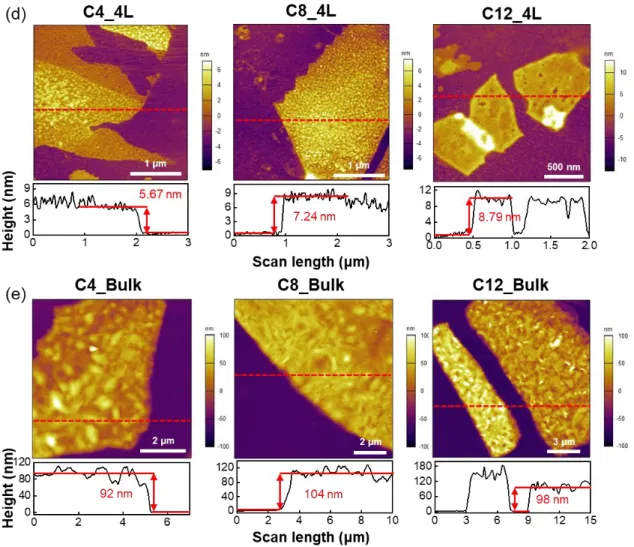
Friction force measurements
RESULTS AND DISCUSSION
Effect of the organic chain length
Given that less compliant materials exhibit more friction [37], we can expect the greatest frictional force to be C4 and a decrease in frictional force with increasing organic chain length. However, it is reported that this softening effect eventually reaches saturation due to the increased length of the organic chain, so C8 and C12 have similar elastic modulus as shown in Figure 6 (a) [17]. Therefore, it is insufficient to consider the greater frictional force at C8 than at C12.
A plausible explanation of this outcome is that adhesion force between the AFM tip and C8 was greater than that between the AFM tip and C12, as shown in figure 6 (b), resulting in higher frictional force of C8. a) The effect of organic chain length on the out-of-plane elastic modulus [17], (b) Average adhesion forces between the AFM tip and atomically thin 2D HOIPs determined before and after FFM measurements. Adhesion strength decreased with increasing organic chain length, but there was no trend associated with the number of layers. On the other hand, for three-layer 2D HOIPs, C8 and C12 showed similar friction force under the same normal force.
In particular, in the case of four-layer 2D HOIPs, it was difficult to find the effect of the organic chain length on friction force, indicating that their dependence on organic chain length becomes less prominent with increasing the number of layers. In addition, for bulk 2D HOIPs, the largest frictional force of C8 was observed, but this outcome is difficult considering that frictional force was influenced by the organic chain length. Due to the large variation of friction force depending on the location, even in the same flake as in figure 7 (b), which makes it difficult to determine the representative friction properties of bulk 2D HOIPs.
It is generally believed that the effect of organic chain length on friction becomes less significant as the number of layers increases and other factors such as topography are believed to cause the local variation in the friction characteristics of atomically thin 2D HOIPs.
![Figure 6. (a) The effect of organic chain length on the out-of-plane elastic modulus [17], (b) Average adhesion forces between the AFM tip and atomically thin 2D HOIPs determined before and after FFM measurements](https://thumb-ap.123doks.com/thumbv2/123dokinfo/10358458.0/20.918.190.719.507.735/figure-organic-elastic-average-adhesion-atomically-determined-measurements.webp)
Effect of the number of layers
Thickness-dependent friction properties were relatively different depending on the proposed type of 2D HOIPs due to their differences in adhesion force induced by the difference in the organic chain length. In general, the frictional force decreased as the number of layers increased from single layer to triple layer. However, the effect of the number of layers was less significant for C12, and all three kinds of bulk 2D HOIPs showed high friction force.
Effect of topography
CONCLUSIONS AND RECOMMENDATIONS
Conclusions
Recommendations for future works
And (c) topographic and (d) FFM images of monolayer C4 obtained simultaneously from the contact mode of AFM. e) Cross-sectional height profiles and (f) friction loops were taken from the red dashed lines. 20] Lv, Y.; Song, X.; Yin, Y.; Feng, Y.; Ma, H.; Hao, C.; Jin, S.; Shi, Y., Hexylammonium iodide-derived two-dimensional perovskite as interfacial passivation layer in efficient two-dimensional/three-dimensional perovskite solar cells. G.; Lemmerer, A., Synthesis, characterization and phase transitions in the inorganic-organic layered perovskite-type hybrids [(CnH2n+1NH3)2PbI4], n = 4, 5 and 6.
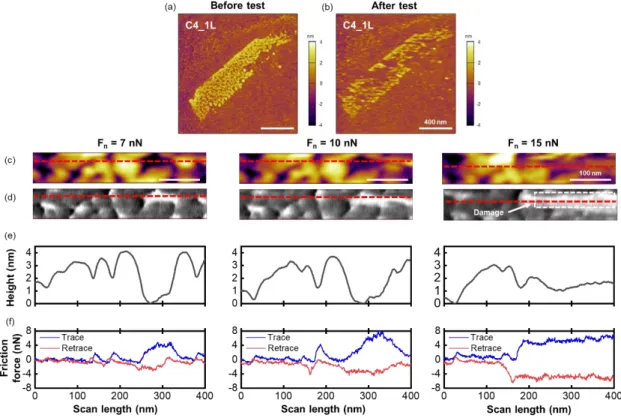
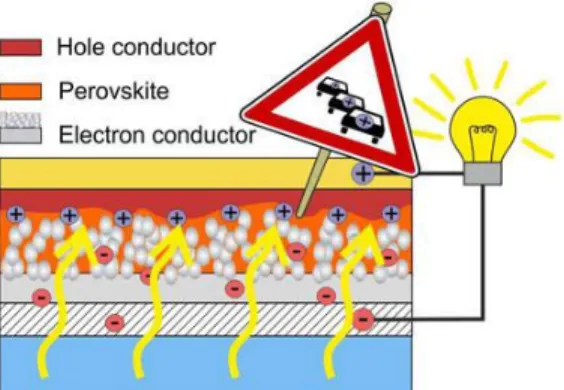
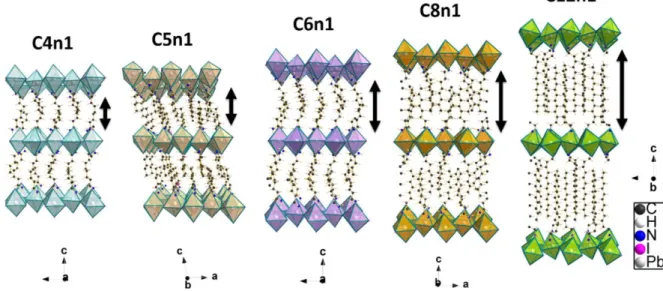
![Figure 4. Determination of the number of layers of 2D HOIPs by comparing with reference values [28-32] and measurement values](https://thumb-ap.123doks.com/thumbv2/123dokinfo/10358458.0/17.918.139.786.217.423/figure-determination-number-layers-hoips-comparing-reference-measurement.webp)
